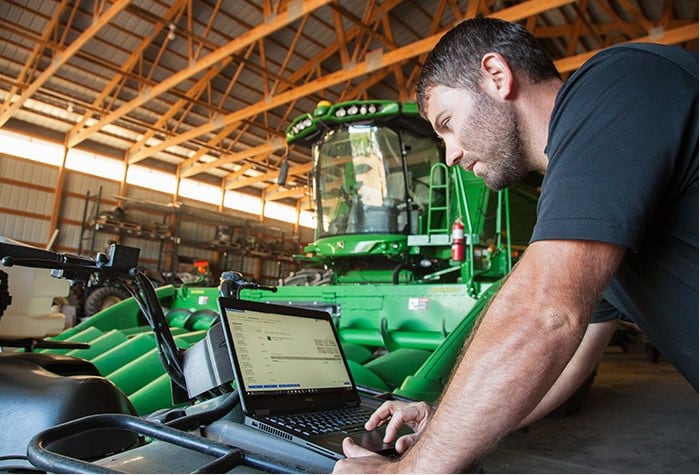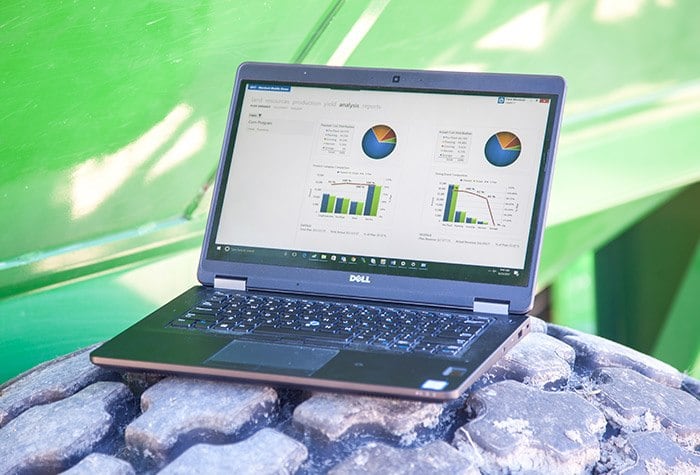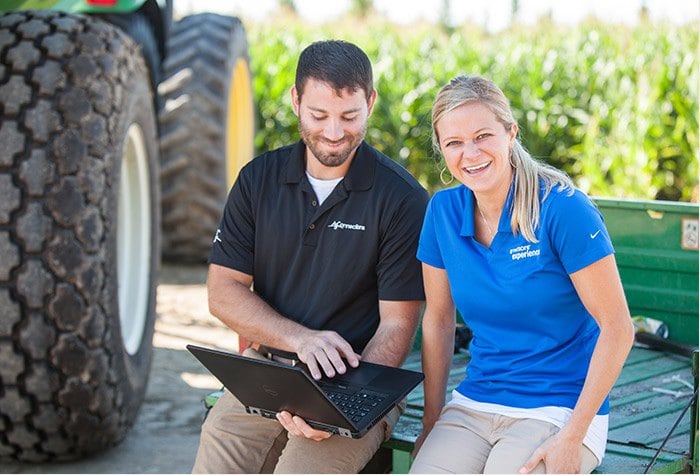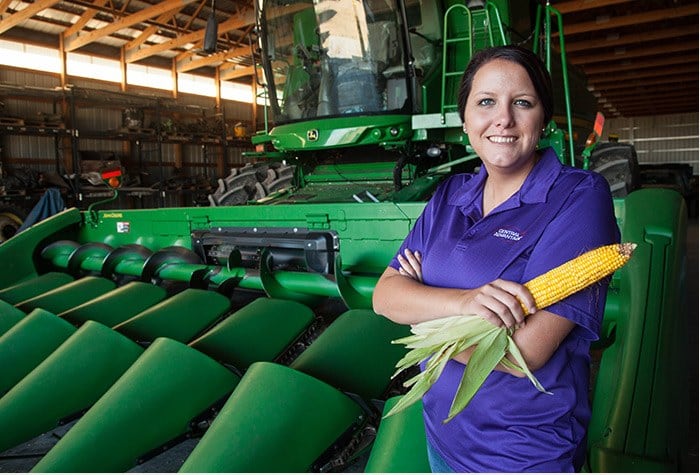Data Can Boost Efficiency and Crop Marketability
The Syngenta Sustainable Solutions group benchmarks data that help growers demonstrate their progress with environmental stewardship.

Technology has given us new ways to tell our stories. We share images and tell anecdotes about our lives on social media. We get news stories from around the world continuously. We can send family members an update instantaneously. Syngenta is using technology to tell growers’ stories, too.
“Syngenta Sustainable Solutions is a program working directly with growers and food companies to help them tell their stories of sustainable farming,” says Macie O’Shaughnessy, Syngenta district manager and former sustainable solutions specialist. “A lot of people have misconceptions and don’t realize how much farming has progressed over the past two decades. This program offers a real-life data story that shows consumers how the agriculture industry is growing more from less.”
In a series of sustainability initiatives across multiple crops and locations, Syngenta is collaborating with consumer brands, processors, growers and channel partners.
“Through the programs, growers provide us with their data and present it in an anonymous and aggregated format,” O’Shaughnessy says. “With real-life data, it shows the progress growers are achieving through management practices, improvements they’re making to their environment and to their farm, and conservation strategies.”
The programs measure different environmental efficiency indicators found in grower data and compare their performance relative to benchmarks. These indicators include land use, soil conservation, irrigation water use, energy use, greenhouse gas (GHG) emissions and nitrogen use.
Knowledge Is Power
Erin Goebel works as a precision agriculture specialist with Central Advantage, the precision agriculture platform at Central Farm Service (CFS) co-op in southern Minnesota. Central Advantage has been tracking input data to make better and more sustainable recommendations for its growers for more than a decade. In 2016, it partnered with Syngenta to implement the Southern Minnesota Corn and Soybean Sustainability Program.
View Photo Gallery
“Sometimes, growers are intimidated by the word sustainability,” says Goebel. “But most of these growers are already following sustainable practices; they just don’t realize it. Syngenta Sustainable Solutions programs give them the opportunity and records to demonstrate what they’re doing to protect the environment.”
Program participants, or reference farmers, are enrolled in AgriEdge Excelsior®, a whole-farm management program from Syngenta. Land.db®, the premium software included in AgriEdge Excelsior, helps growers track inputs and management strategies throughout the season to produce these records. When signing on as participating farmers, growers agree to anonymously share these records, which are aggregated then analyzed for program results.
Goebel says that in southern Minnesota, one of the main indicators her group is looking at is nitrogen use. Historically, growers would apply a flat rate of fertilizer to an entire farm. Now, Goebel is showing her customers how to manage each acre differently.
“Before sidedressing, we take soil samples to analyze the nitrate levels,” she says. “We then provide recommendations based off those levels that allow the grower to only apply what is needed for the crop. We’re also using variable-rate technology and adjusting, based off the soil characteristics. We want to make sure we’re putting on the nitrogen in the most efficient way.”
By breaking down their farms on an acre-by-acre basis, Goebel can help her growers make more financially and sustainably beneficial input purchases. In 2016, the Southern Minnesota Corn Sustainability Program demonstrated a 2 percent and 4 percent nitrogen use efficiency score, above district and state benchmarks respectively. Of the 184 fields included in the program, soil tests were performed on 154. Those fields required about 7 pounds less nitrogen per acre.
“In addition to the sustainability aspect, Land.db helps us purchase and use only what we need,” Goebel says. “Previously, my dad would sit down in November and figure out where he was after harvest. Now, we can keep track of the inputs as we go through the season. For example, we can determine whether or not spending an extra $35 an acre on a fungicide will allow us to make money in the end. It’s easier to make solid, financial decisions.”
Watch Video
Open Communication
The benefit of these programs and records goes beyond inputs and outputs from the field. It also impacts the value of crops.
“Farming is difficult work,” says Butch Ewen, owner and founder of Ewen Farms near Ballantine, Montana. “The public needs to be informed about the better crops we are growing, and they need to understand all the things we are doing to preserve the land.”
Ewen grows sugarbeets, grain corn, malt barley, hay and wheat. His farm is part of the Syngenta Yellowstone Watershed Program. In this region, water is scarce, so Ewen irrigates most of the land on his 2,700-acre farm.
During 2015-2016, the Yellowstone Watershed Barley Program demonstrated a water-use efficiency score of 47 percent and 64 percent above regional and state benchmarks, respectively, and reported a 24-bushel-per-acre yield advantage over regional benchmarks.
As one of the largest drivers for energy and GHG contributions, it’s important for growers in this area to irrigate as efficiently as possible. As a result, they implemented conservation practices, like grass waterways, tailwater recovery systems, conservation covers, field borders and contour-strip cropping, on 41 percent of the barley fields in the program. These practices support efficient use of water inputs, while conserving soil and nutrients on the field.
Being part of this program and having access to the records in Land.db have helped Ewen tell his conservation story to downstream partners more effectively.
A Story for Everyone
At a time when consumers are demanding to know more about where their food and products come from, growers are just as eager to share that information—and to provide evidence of sustainability.
“Once consumers understand how to read our reports, they’ll realize we’re not just trying to produce enough food to feed the world,” Goebel says. “We’re also trying to help the environment. For us, sustainability is making sure our land is better for generations to come, and Syngenta is helping us tell that story.”
“Syngenta Sustainable Solutions is a program working directly with growers and food companies to help them tell their stories of sustainable farming,” says Macie O’Shaughnessy, Syngenta district manager and former sustainable solutions specialist. “A lot of people have misconceptions and don’t realize how much farming has progressed over the past two decades. This program offers a real-life data story that shows consumers how the agriculture industry is growing more from less.”
In a series of sustainability initiatives across multiple crops and locations, Syngenta is collaborating with consumer brands, processors, growers and channel partners.
“Through the programs, growers provide us with their data and present it in an anonymous and aggregated format,” O’Shaughnessy says. “With real-life data, it shows the progress growers are achieving through management practices, improvements they’re making to their environment and to their farm, and conservation strategies.”
The programs measure different environmental efficiency indicators found in grower data and compare their performance relative to benchmarks. These indicators include land use, soil conservation, irrigation water use, energy use, greenhouse gas (GHG) emissions and nitrogen use.
Knowledge Is Power
Erin Goebel works as a precision agriculture specialist with Central Advantage, the precision agriculture platform at Central Farm Service (CFS) co-op in southern Minnesota. Central Advantage has been tracking input data to make better and more sustainable recommendations for its growers for more than a decade. In 2016, it partnered with Syngenta to implement the Southern Minnesota Corn and Soybean Sustainability Program.
View Photo Gallery
“Sometimes, growers are intimidated by the word sustainability,” says Goebel. “But most of these growers are already following sustainable practices; they just don’t realize it. Syngenta Sustainable Solutions programs give them the opportunity and records to demonstrate what they’re doing to protect the environment.”
Program participants, or reference farmers, are enrolled in AgriEdge Excelsior®, a whole-farm management program from Syngenta. Land.db®, the premium software included in AgriEdge Excelsior, helps growers track inputs and management strategies throughout the season to produce these records. When signing on as participating farmers, growers agree to anonymously share these records, which are aggregated then analyzed for program results.
Goebel says that in southern Minnesota, one of the main indicators her group is looking at is nitrogen use. Historically, growers would apply a flat rate of fertilizer to an entire farm. Now, Goebel is showing her customers how to manage each acre differently.
“Before sidedressing, we take soil samples to analyze the nitrate levels,” she says. “We then provide recommendations based off those levels that allow the grower to only apply what is needed for the crop. We’re also using variable-rate technology and adjusting, based off the soil characteristics. We want to make sure we’re putting on the nitrogen in the most efficient way.”
By breaking down their farms on an acre-by-acre basis, Goebel can help her growers make more financially and sustainably beneficial input purchases. In 2016, the Southern Minnesota Corn Sustainability Program demonstrated a 2 percent and 4 percent nitrogen use efficiency score, above district and state benchmarks respectively. Of the 184 fields included in the program, soil tests were performed on 154. Those fields required about 7 pounds less nitrogen per acre.
In addition to her work at CFS, Goebel also helps on her father’s farm, Wayne Goebel Farms in Mankato, Minnesota, which is enrolled in the Southern Minnesota Corn and Soybean Sustainability Program. After discovering that their nitrogen use wasn’t as efficient as other farms in the area, she and her family adjusted their plan in 2017.“Farming is difficult work. The public needs to be informed about the better crops we are growing, and they need to understand all the things we are doing to preserve the land.”
“In addition to the sustainability aspect, Land.db helps us purchase and use only what we need,” Goebel says. “Previously, my dad would sit down in November and figure out where he was after harvest. Now, we can keep track of the inputs as we go through the season. For example, we can determine whether or not spending an extra $35 an acre on a fungicide will allow us to make money in the end. It’s easier to make solid, financial decisions.”
Watch Video
Open Communication
The benefit of these programs and records goes beyond inputs and outputs from the field. It also impacts the value of crops.
“Farming is difficult work,” says Butch Ewen, owner and founder of Ewen Farms near Ballantine, Montana. “The public needs to be informed about the better crops we are growing, and they need to understand all the things we are doing to preserve the land.”
Ewen grows sugarbeets, grain corn, malt barley, hay and wheat. His farm is part of the Syngenta Yellowstone Watershed Program. In this region, water is scarce, so Ewen irrigates most of the land on his 2,700-acre farm.
During 2015-2016, the Yellowstone Watershed Barley Program demonstrated a water-use efficiency score of 47 percent and 64 percent above regional and state benchmarks, respectively, and reported a 24-bushel-per-acre yield advantage over regional benchmarks.
As one of the largest drivers for energy and GHG contributions, it’s important for growers in this area to irrigate as efficiently as possible. As a result, they implemented conservation practices, like grass waterways, tailwater recovery systems, conservation covers, field borders and contour-strip cropping, on 41 percent of the barley fields in the program. These practices support efficient use of water inputs, while conserving soil and nutrients on the field.
Being part of this program and having access to the records in Land.db have helped Ewen tell his conservation story to downstream partners more effectively.
@SyngentaUS Sustainable Solutions group using #agtech to show growers’ progress with environmental stewardship.
“Tools like this make my job easier,” Ewen says. “Land.db helps me track different aspects of my operation and helps me sell my products more successfully. Consumers lack accurate information about the impact of commodities being imported from other countries. Often, those products are much lower in quality than the crops I grow, but their presence puts me at a big risk of lost sales.”
click to tweet ![]()
A Story for Everyone
At a time when consumers are demanding to know more about where their food and products come from, growers are just as eager to share that information—and to provide evidence of sustainability.
“Once consumers understand how to read our reports, they’ll realize we’re not just trying to produce enough food to feed the world,” Goebel says. “We’re also trying to help the environment. For us, sustainability is making sure our land is better for generations to come, and Syngenta is helping us tell that story.”







